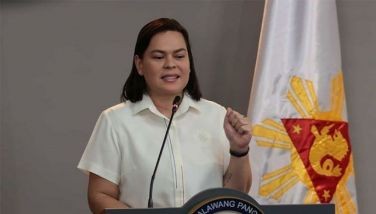Grade school books: Errors still abound
June 16, 2005 | 12:00am
It seems that the textbook controversy is far from over.
After a review panel convened by the Department of Education (DepEd) confirmed that there were indeed factual and grammatical errors in some history and science books used in public and private schools since the early 1990s, everybody assumed there would now be efforts to correct the errors and that publishing houses would be more careful with their facts.
In a letter to The STAR, the man who first brought the textbook errors to the public’s attention last year now says that 24 books recently published by the Phoenix Publishing House Inc. are riddled with errors.
"The reason history repeats itself is that most people weren’t listening the first time... Apparently, most textbook authors and publishers simply weren’t listening then. Not paying attention, they are thus condemned to make the same mistakes over and over again," wrote Antonio Calipjo Go, academic supervisor of Marian School of Quezon City.
Go claimed that two sets of textbooks and activity books put out by Phoenix Publishing — "Harnessing English Arts Today" and "Simply Science in the Next Century" — are filled with errors.
The book series for Grades 1 and 2, "Harnessing English Arts Today," for example, had 115 errors each, while the Grade 3 book contained 261 errors. Books for Grades 4, 5 and 6 had 175, 321 and 184 errors, respectively.
On the other hand, all six books in the series "Simply Science in the Next Century" had about the same number of errors in each book.
According to Go, the books were submitted to him for evaluation on Nov. 25, 2004. What was disturbing, he said, was that after he informed Phoenix of his findings early this year, PPHI staff had assured him that the copies had been corrected.
"When I went over them, I found that they were exactly the same as those I had examined," Go said, explaining why he was compelled to reveal his findings to the media.
In an article entitled "Donkeys In A World of Horses" which he submitted for publication, he said he had sought to warn the public about the 24 "very defective textbooks."
Nowhere is the defective nature of the textbooks more evident, Go wrote in his article, than in the title of one of the series itself: "Simply Science in the Next Century."
"The word ‘simply’, being an adverb, may not modify the word ‘science’, a noun," he explained. "Moreover, we should be concerned with what is happening in our time, in this century, and not in the next century."
The correct title, he said, should have been "Simplified Science in the 21st Century" or "21st Century Science Made Simple."
In the series "Harnessing English Arts Today," Go asked: "How can these series of textbooks be expected to teach communication skills in English when it does not know what it wants to say, and it does not know how to say it?"
But what’s a minor lapse in the title when the contents of the books are choking with grammatical gaffes and other hilarious mistakes?
Consider these: "His ears got sick/ The late pupils missed her lessons/ Business is brisk and money is rolling air/ The enkantada fell in love to a handsome man who fell in love to a pretty lady/
Who is the editor-in-charge in your school organ?/ The tutor tooted the flute/ Kill two birds in one stone."
Now, Go asked, can we really blame college graduates for the quality of English they bring to the workplace?
Grammar is one thing, of course; context is another.
Also from the "Harnessing English Arts" series: "The symphony was so huge and hard to play/ The sea was restless like a giant tossing and snoring in his sleep/ Speak loudly for the protection of the earth/ The earth is a basketball that rolls and rolls/ He loved to play so much that he kept his toys the moment he became aware of them/ The gardener cut down the bamboo, lopped off its branches and hollowed out its insides."
One of the factors often cited for the deteriorating quality of Philippine education is the lack of textbooks, especially in public schools.
But what about schools with textbooks that provide students with information such as the following:
"The hunchback could not stand straight/ About 88 constellations cover the sky completely/ Plants and animals are living things. They breathe because they have lungs/ Very hard steel is a brittle metal/ The colors of a rainbow are the same as the colors of a white light."
Go said the mis-education of Filipinos continues if we publish textbooks that define muro-ami as "fishing method using sticks and rods" and mummification as "a drying process that forms fossils."
Or what about a health entry that offers this advice to Grade V pupils — "Have regular checkups for STDs even in the absence of symptoms. Learn the common symptoms of STDs. Seek medical help immediately if any suspicious symptoms develop."
In compiling these errors, Go lamented that "the 12 Science textbooks were written by teachers of the Ateneo de Manila Grade School while the 12 English textbooks were written by members of the teaching and administrative staff of St. Theresa’s College of Quezon City.
"Who pays for the mistakes kids ‘learn’ while they are supposed to be learning in school?" Go asked.
After a review panel convened by the Department of Education (DepEd) confirmed that there were indeed factual and grammatical errors in some history and science books used in public and private schools since the early 1990s, everybody assumed there would now be efforts to correct the errors and that publishing houses would be more careful with their facts.
In a letter to The STAR, the man who first brought the textbook errors to the public’s attention last year now says that 24 books recently published by the Phoenix Publishing House Inc. are riddled with errors.
"The reason history repeats itself is that most people weren’t listening the first time... Apparently, most textbook authors and publishers simply weren’t listening then. Not paying attention, they are thus condemned to make the same mistakes over and over again," wrote Antonio Calipjo Go, academic supervisor of Marian School of Quezon City.
Go claimed that two sets of textbooks and activity books put out by Phoenix Publishing — "Harnessing English Arts Today" and "Simply Science in the Next Century" — are filled with errors.
The book series for Grades 1 and 2, "Harnessing English Arts Today," for example, had 115 errors each, while the Grade 3 book contained 261 errors. Books for Grades 4, 5 and 6 had 175, 321 and 184 errors, respectively.
On the other hand, all six books in the series "Simply Science in the Next Century" had about the same number of errors in each book.
According to Go, the books were submitted to him for evaluation on Nov. 25, 2004. What was disturbing, he said, was that after he informed Phoenix of his findings early this year, PPHI staff had assured him that the copies had been corrected.
"When I went over them, I found that they were exactly the same as those I had examined," Go said, explaining why he was compelled to reveal his findings to the media.
In an article entitled "Donkeys In A World of Horses" which he submitted for publication, he said he had sought to warn the public about the 24 "very defective textbooks."
"The word ‘simply’, being an adverb, may not modify the word ‘science’, a noun," he explained. "Moreover, we should be concerned with what is happening in our time, in this century, and not in the next century."
The correct title, he said, should have been "Simplified Science in the 21st Century" or "21st Century Science Made Simple."
In the series "Harnessing English Arts Today," Go asked: "How can these series of textbooks be expected to teach communication skills in English when it does not know what it wants to say, and it does not know how to say it?"
But what’s a minor lapse in the title when the contents of the books are choking with grammatical gaffes and other hilarious mistakes?
Consider these: "His ears got sick/ The late pupils missed her lessons/ Business is brisk and money is rolling air/ The enkantada fell in love to a handsome man who fell in love to a pretty lady/
Who is the editor-in-charge in your school organ?/ The tutor tooted the flute/ Kill two birds in one stone."
Now, Go asked, can we really blame college graduates for the quality of English they bring to the workplace?
Grammar is one thing, of course; context is another.
Also from the "Harnessing English Arts" series: "The symphony was so huge and hard to play/ The sea was restless like a giant tossing and snoring in his sleep/ Speak loudly for the protection of the earth/ The earth is a basketball that rolls and rolls/ He loved to play so much that he kept his toys the moment he became aware of them/ The gardener cut down the bamboo, lopped off its branches and hollowed out its insides."
But what about schools with textbooks that provide students with information such as the following:
"The hunchback could not stand straight/ About 88 constellations cover the sky completely/ Plants and animals are living things. They breathe because they have lungs/ Very hard steel is a brittle metal/ The colors of a rainbow are the same as the colors of a white light."
Go said the mis-education of Filipinos continues if we publish textbooks that define muro-ami as "fishing method using sticks and rods" and mummification as "a drying process that forms fossils."
Or what about a health entry that offers this advice to Grade V pupils — "Have regular checkups for STDs even in the absence of symptoms. Learn the common symptoms of STDs. Seek medical help immediately if any suspicious symptoms develop."
In compiling these errors, Go lamented that "the 12 Science textbooks were written by teachers of the Ateneo de Manila Grade School while the 12 English textbooks were written by members of the teaching and administrative staff of St. Theresa’s College of Quezon City.
"Who pays for the mistakes kids ‘learn’ while they are supposed to be learning in school?" Go asked.
BrandSpace Articles
<
>
- Latest
- Trending
Trending
Latest
Trending
Latest
Recommended
































